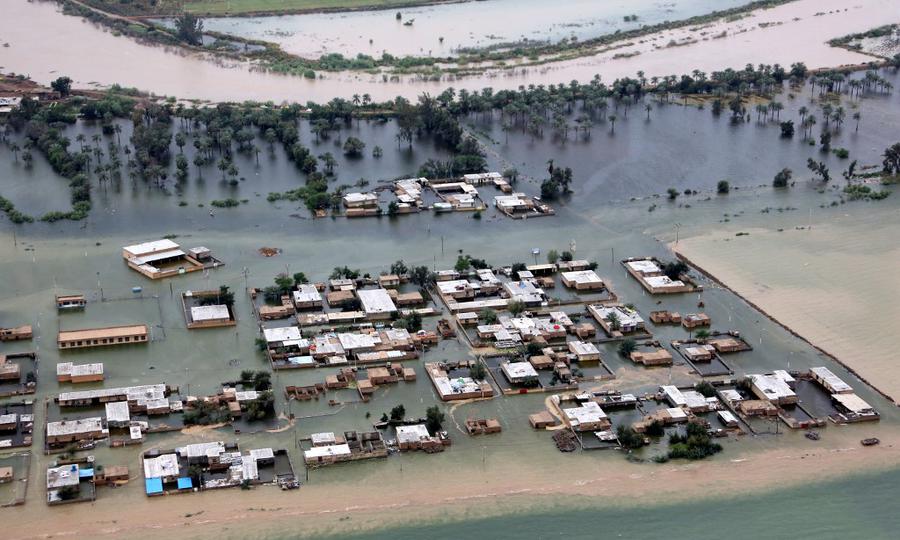Kourosh Ziabari – Asia Times: Three months after flash floods submerged large swaths of Iran and nearly two years after a massive earthquake devastated its western Kermanshah Province, the suffering of crisis-stricken Iranians seems to have been consigned to oblivion.
Paralyzed by crushing US sanctions, the government of President Hassan Rouhani has performed poorly in delivering aid to people living in the affected areas, and construction efforts have been dismally sluggish as thousands of Iranians are still homeless and living in shelters and makeshift camps.
No where is that suffering more obvious than Iran’s already neglected minority regions, which have born the brunt of climate change and snowballing natural disasters.
Minorities left behind
Unprecedented floods that started in mid-March and continued for more than one month ripped through 26 of Iran’s 31 provinces. They were believed to have claimed 76 lives and caused more than US$2.2 billion in damages, including hundreds of bridges and thousands of kilometers of roads.
One of the provinces most affected by the flooding was Khuzestan, an Arab-majority region bordering southern Iraq and the Persian Gulf. Other affected regions were Golestan, a Sunni-majority province with a sizable Turkmen population, and Lorestan, whose inhabitants – the Lurs – are an ethnic minority.
The agricultural sector was mutilated in a usually arid country, which relies on seasonal rainfall to sustain its national water supply and agronomy. Some cities were reported to have received 70% of their annual rainfall in the span of only five days, and entire communities were submerged.
The flash floods were only the latest natural disaster to hit the country. Nearly two years ago, a 7.3 magnitude earthquake struck the Iran-Iraq border province of Kermanshah, killing 574 people and leaving 70,000 homeless in the Kurdish-majority region.
According to Mansour Moradi, a member of Iran’s parliament, the earthquake inflicted more than $152 million in damages, and the region has still not recovered from the woes of that deadly tremor.
Despite significant donations by Iranian people and popular efforts led by celebrities and domestic charity organizations, hundreds of Kermanshah citizens and villagers still live in temporary shelters and have not received any assistance from the government to reconstruct their ravaged homes or move to nearby cities where affordable housing is available.
“These natural disasters mostly hit provinces with a sizable non-Persian, ethnic population,” Dr Ali Fathollah-Nejad, a visiting fellow at the Brookings Doha Center, told Asia Times.
They are suffering the brunt of climate change, combined with disproportionate socio-economic stagnation, which has translated into high levels of public frustration with the central government, he said.
“This mixture of grievances also provides the basis for anti-regime activism,” he warned.
Climate change doubled
Meanwhile, the hardships of climate change appear set to grow. According to Zahra Falahat, the Iranian Red Crescent’s under-secretary-general for international affairs and international humanitarian law, the March and April flooding was the “largest disaster to hit Iran in more than 15 years.”
The head of Iran’s Meteorological Organization, Sahar Tajbakhsh, said the floods were a direct result of climate change and global warming.
In 2018 Mohammad Darvish, the secretary of environmental policy at the government-linked Center for Strategic Studies, warned that the impacts of climate change on Iran were double the world average.
In recent years, the country has been experiencing dust storms, record-breaking temperatures, droughts and floods as well as the drying of lakes and rivers.
And yet Iran is one of only 11 countries that have signed but not ratified the Paris Climate Agreement. Hardliners are opposed to it, as they despise anything that leads to further integration of Iran in the international community.
Sanctions and mismanagement
Notwithstanding some limited humanitarian assistance from Iran’s neighbors and a few European nations, the international community did not rush to help Iran in the wake of the overwhelming floods.
The lack of response, however, should be seen against the backdrop of Iran’s growing isolation and the tightening of US sanctions.
“The sanctions affect every civilian aspect of life in Iran from the availability of pharmaceuticals and medical support to logistics and access to emergency funds,” said Arshin Adib-Moghaddam, a professor in Global Thought and Comparative Philosophies at the School of Oriental and African Studies in London.
Government mismanagement, he said, constitutes another key factor.
At the height of the controversy over the floods and while the administration of Hassan Rouhani was being relentlessly grilled by the media and critics over mismanagement and the lack of an appropriate and swift response to the tragedy, Iran’s Red Crescent reported in desperation the inability to take donations from overseas, including from Iranian expatriates in other countries, as a result of the US sanctions against the Islamic Republic.
On April 2, Iranian Foreign Minister Javad Zarif tweeted that the Iranian Red Crescent was not able to receive any funds due to the US sanctions, calling on the United States to own up to its “economic terrorism.”
US Secretary of State Mike Pompeo responded the same day, saying Washington was ready to contribute to the International Federation of Red Cross, which could in turn direct the money to Iran, while also blaming Tehran for “mismanagement in urban planning and in emergency preparedness.”
Mohammad Eslami, Iran’s Minister of Roads and Urban Development, announced earlier this year that nearly 150,000 housing units in the flood-stricken cities and villages sustained damage, one-third of which required full reconstruction.
Many people in the affected areas are still homeless and the government appears to have no concrete plans to make up for their loss as the Persian Gulf country’s oil sales have reportedly plummeted to about 100,000 barrels per day, depriving it of its most important source of income.
Iran’s Parliament Speaker Ali Larijani said the new year’s budget does not suffice to cover the flood damages. The government, he said, would have to turn to other sources of support.
This article was originally published on Asia Times.

